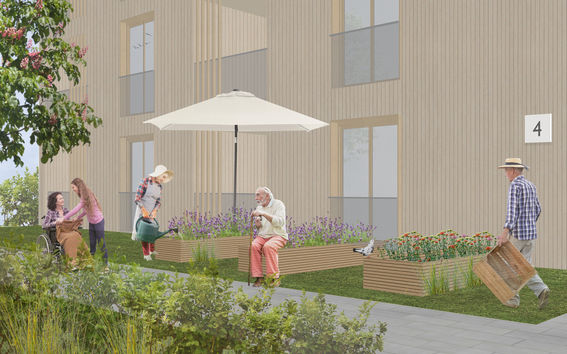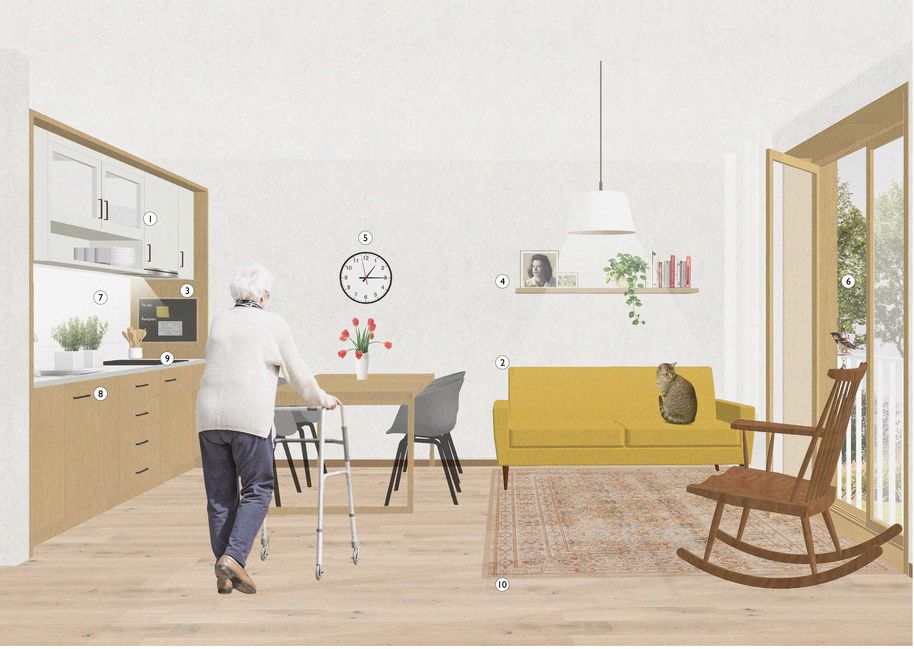Flexibility and community support for people with memory problems

Current housing solutions for older people and people with memory decline are too rigid and do not serve all those who need them. In order to take the individual better into account, we must seek for new solutions.
‘In Finland today, people live at home for as long as possible and then go straight to residential care with 24-hour services. There are no solutions in between for lighter assistance, even if there is a need for it’, says Ira Verma, a senior scientist at the Aalto University Department of Architecture, who is working on the MonIA project.
The MonIA project on integrated living for people with memory decline sought solutions for the future housing of people with memory impairment. The aim was to find ways to ensure that people with memory problems do not have to move out of their familiar living environment at any stage of their life cycle. This requires the joint development of housing, services and policies.
The project, which ended in May 2022, was coordinated by the SOTERA research group of the Department of Architecture and involved government institutions, private and public sector developers and service providers, the cities of Helsinki,Jyväskylä, Porvoo, Pori and Kirkkonummi, the Housing Financing and Development Centre Ara and the Ministry of the Environment.
Community spirit and flexibility provide security
The project explored existing solutions that were perceived as good and suitable for future needs. In addition to domestic sites, solutions from other Nordic countries, Europe and Canada were also examined for their suitability in Finland.
The aim was to find ways to enable people with memory decline to live as part of the community and to reduce their isolation. The potential of multigenerational living environments and community living to support people with memory problems in their daily lives and to increase their participation in the community was also explored.
Senior scientist Ira Verma, Aalto UniversityThe buildings now built should last for decades. We also need to think what kind of living environment we want to have when we are elderly."
Safe housing for people with memory decline is influenced, among other things, by the location of the home and the design of the building and grounds: attention must be paid to the accessibility, clarity and ease of orientation of the overall layout.
The project developed flexible housing solutions and looked at ways of moving from residential care towards normal housing. The conditions for making ordinary rental houses age and memory friendly were also examined. For example, communal spaces can promote social interaction, which is important for maintaining social contacts for people with memory problems.
Proposals for municipalities
The project has produced design solutions and research, a joint report and several guidelines on what to consider when designing memory-friendly housing. The eight graduate students involved in the project made presentations to municipalities on concrete ways to create good housing for people with memory problems. These included both new construction and renovation.
‘The practical measures are left to the municipalities. We provide new ideas and good practices, but it is up to the municipalities to decide how to finance and implement them’, says Ira Verma.
There are several financing challenges. Housing needs to be affordable for residents, which affects, for example, the number and size of common rooms. Other important qualitative issues include outward views, colours and contrasts, lighting and the sound environment.
‘These are things that can be influenced and do not necessarily affect the price. But on quality of life they do have an impact’, says Verma.
During the project, users of housing services have also been consulted, including through student-led workshops where residents and other service users have shared their suggestions on how to improve housing. The main wish of the residents has been to be able to continue living as normally as possible at home and to receive help when needed. Often it is the restriction of self-determination that people fear.
User-centred design requires flexible and individually tailored solutions. A wider range of housing solutions should be available.
Buildings have a long life cycle and the need for assisted living will change, so the housing that is implemented must be flexible and adaptable also for other groups of residents.
‘The buildings that are being built now should last for decades to come. We also need to think about the kind of living environment we want to live in when we ourselves are elderly.’
According to Verma, the municipalities have been positively involved in the work. ‘There is a willingness to safeguard a good quality of life and the rights of people with memory problems.’

Examples of solutions by students:
Memory-friendly and communal housing
There are many architectural factors that influence the memory-friendly nature of a living environment. It is important to consider how social contact, replacement of impaired abilities and support for residual skills is provided in the built environment. This attention to social contact is particularly important because people with memory problems are often at risk of exclusion. The work involved the design of a memory-friendly and community-based residential building in Kasvihuoneenkatu in Pori (Kiikkilä, Outi) and Kuokkala in Jyväskylä (Sevele, Luiza). It also presents key design principles to guide the design of memory-friendly living environments. Important themes include familiarity, environmental flexibility, and the understandability and perceptibility of environments.
The role of the senses in memory-friendly housing
Memory loss causes changes in sensory experience and a wide range of auditory symptoms. Acoustic design has the potential to support the daily life and independence of the person affected. As there is no cure for progressive memory loss, the aim is to safeguard the quality of life and meet the needs of people with memory loss. The design of a memory and age-friendly living environment must take into account changes in sensory experience and the auditory environment as part of the multisensory experience. Guidelines have been developed to help design a memory-friendly sound environment (Salminen, Viivi).
Neighbourhoods suitable for people with memory impairment
The design of public outdoor spaces can influence the suitability of the living environment for people with memory impairment. Attention should be paid to how the design of spaces can influence, for example, safety and comfort. Olga Juutistenaho's work presents a framework that can be used to support design. It includes an analysis of the city under review and a development vision on how to design a memory-friendly environment. Tammela, Tampere, is used as an example urban area. Jiaxin Tao examined the role of smart technology in the living environment of people with memory problems.
Features to take into account when developing housing solutions for people with memory impairment:
- Diversity
Good housing solutions and services are diverse and all are needed. Residents have different needs and aspirations for their housing, and their life situations can also be very different. The idea that everyone should be offered the same is counterproductive. The starting point should be the home and the resident's own choices about how they want to live and manage their housing.
- Integration
No group of residents should be excluded from the housing community. People with memory problems should not be moved away from familiar neighbourhoods or isolated by gates and locks. They should be included and integrated into the community just like any other resident. This requires social inclusiveness and flexibility of the physical environment. The effective organisation of care services should not lead to 'forced migration', but should be flexible to the resident.
- Flexibility
Residents, their individual needs and the symptoms of memory disorders should be taken into account in the design of housing. This means making the facilities flexible to the changing needs of the person with memory impairment, in a way that supports and enhances the remaining skills of the person with memory impairment. The clarity of the environment, visual contact between spaces and familiarity support the resident's ability to function and experience control of the space.
- Outdoor spaces
Outdoor spaces are easily overlooked when considering housing for people with memory decline. However, it is important to enable people to go outdoors and run their own errands, such as shopping. Services close to home and the public urban environment can also support people with memory problems. Landmarks, familiar routes, good signposting and lighting, benches and rest areas are all helpful. Providers of commercial services should also take memory-friendly features into account.
Text: Venla Välikangas
- Published:
- Updated:
Read more news

DeployAI Partners Gather for Heart Beat Meeting in Helsinki
The European DeployAI project's partners gathered for the Heart Beat meeting hosted by Aalto University Executive Education in Helsinki.
Get to know us: Associate Professor Maria Sammalkorpi
Sammalkorpi received her doctorate from Helsinki University of Technology 2004. After her defence, she has worked as a researcher at the Universities of Princeton, Yale and Aalto.
Aalto computer scientists in ICML 2024
Computer scientists in ICML 2024